| New Delhi नई दिल्ली نئ دہلی ਦੇਹਲੀ | |
|---|---|
| Municipal corporation | |
| Above: Clockwise from top: Tomb of Safdarjung,India Gate, Rashtrapati Bhavan, Laxminarayan Temple, Connaught Place. | |
| Nickname(s): (Punjabi: ਦਿਲ੍ਲੀ) | |
| Coordinates: 28°36′50″N 77°12′32″ECoordinates: 28°36′50″N 77°12′32″E | |
| Country | |
| State | National Capital Territory of Delhi |
| Established | 1911 |
| Government | |
| • Lieutenant Governor | Najeeb Jung |
| • Chief Minister | Arvind Kejriwal |
| Area[1] | |
| • Municipal corporation | 42.7 km2(16.5 sq mi) |
| Elevation | 216 m (709 ft) |
| Population (2011)[2] | |
| • Municipal corporation | 249,998 |
| • Density | 5,854.7/km2(15,164/sq mi) |
| • Metro | 21,753,486 |
| Time zone | IST (UTC+5:30) |
| Pincode(s) | 110xxx |
| Area code(s) | +91-11 |
| Vehicle registration | DL-1x-x-xxxx to DL-13x-x-xxxx |
| Official languages | Hindi, Punjabi |
| Website | www.ndmc.gov.in |
New Delhi  i/ˈnjuː dɛli/ is the capital of India and seat of the executive, legislative, and judiciary branches of the Government of India. It is also the centre of the Government of the National Capital Territory of Delhi. New Delhi is situated within the metropolis of Delhi and is one of the elevendistricts of Delhi National Capital Territory.
i/ˈnjuː dɛli/ is the capital of India and seat of the executive, legislative, and judiciary branches of the Government of India. It is also the centre of the Government of the National Capital Territory of Delhi. New Delhi is situated within the metropolis of Delhi and is one of the elevendistricts of Delhi National Capital Territory.
The foundation stone of the city was laid by George V, Emperor of India during the Delhi Durbar of 1911.[3] It was designed by British architects,Sir Edwin Lutyens and Sir Herbert Baker. The new capital was inaugurated on 13 February 1931,[4] by India's Viceroy Lord Irwin.
Contents
[hide]Establishment[edit]
Calcutta (now Kolkata) was the capital of India during the British Raj until December 1911. However, Delhi had served as the political and financial centre of several empires of ancient India and the Delhi Sultanate, most notably of the Mughal Empire from 1649 to 1857. During the early 1900s, a proposal was made to the British administration to shift the capital of the British Indian Empire (as it was officially called) from Calcutta to Delhi.[5] Unlike Calcutta, which was located on the eastern coast of India, Delhi was located in northern India and the Government of British Indiafelt that it would be easier to administer India from Delhi rather than from Calcutta.[5]
On 12 December 1911, during the Delhi Durbar, George V, the then Emperor of India, along with Queen Mary, his Consort, made the announcement[6][7] that the capital of the Raj was to be shifted from Calcutta to Delhi, while laying the foundation stone for the Viceroy's residence in the Coronation Park, Kingsway Camp.[8][9] The foundation stone[10] of New Delhi was laid by King George V and Queen Mary at the site of Delhi Durbar of 1911 at Kingsway Camp on 15 December 1911, during their imperial visit. Large parts of New Delhi were planned by Edwin Lutyens (Sir Edwin from 1918), who first visited Delhi in 1912, and Herbert Baker (Sir Herbert from 1926), both leading 20th-century British architects.[11] The contract was given to Sobha Singh (later Sir Sobha Singh). Construction really began after World War I and was completed by 1931. The city that was later dubbed "Lutyens' Delhi" was inaugurated on 13 February 1931 by Lord Irwin, the Viceroy. Lutyens designed the central administrative area of the city as a testament to Britain's imperial aspirations.[12][13]
Soon Lutyens started considering other places. Indeed, the Delhi Town Planning Committee, set up to plan the new imperial capital, with George Swinton as chairman and John A. Brodie and Lutyens as members, submitted reports for both North and South sites. However, it was rejected by the Viceroy when the cost of acquiring the necessary properties was found to be too high. The central axis of New Delhi, which today faces east at India Gate, was previously meant to be a north-south axis linking the Viceroy's House at one end with Paharganj at the other. During the project's early years, many tourists believed it was a gate from Earth to Heaven itself.[14] Eventually, owing to space constraints and the presence of a large number of heritage sites in the North side, the committee settled on the South site.[15] A site atop the Raisina Hill, formerly Raisina Village, a Meo village, was chosen for the Rashtrapati Bhawan, then known as the Viceroy's House. The reason for this choice was that the hill lay directly opposite the Dinapanah citadel, which was also considered the site of Indraprastha, the ancient region of Delhi. Subsequently, the foundation stone was shifted from the site of Delhi Durbar of 1911–1912, where the Coronation Pillar stood, and embedded in the walls of the forecourt of the Secretariat. The Rajpath, also known as King's Way, stretched from the India Gate to the Rashtrapati Bhawan. The Secretariat building, the two blocks of which flank the Rashtrapati Bhawan and house various ministries of the Government of India, and the Parliament House, both designed by Herbert Baker, are located at the Sansad Marg and run parallel to the Rajpath.
In the south, land up to Safdarjung's Tomb was acquired in order to create what is today known as Lutyens' Bungalow Zone.[16] Before construction could begin on the rocky ridge of Raisina Hill, a circular railway line around the Council House (now Parliament House), called the Imperial Delhi Railway, was built to transport construction material and workers for the next twenty years. The last stumbling block was the Agra-Delhi railway line that cut right through the site earmarked for the hexagonal All-India War Memorial (India Gate) and Kingsway (Rajpath), which was a problem because the Old Delhi Railway Station served the entire city at that time. The line was shifted to run along Yamuna river, and it began operating in 1924. The New Delhi Railway Station opened in 1926 with a single platform at Ajmeri Gate near Paharganj and was completed in time for the city's inauguration in 1931.[17][18] As construction of the Viceroy's House (the present Rashtrapati Bhavan), Central Secretariat, Parliament House, and All-India War Memorial (India Gate) was winding down, the construction of a shopping district and a new plaza, Connaught Place, began in 1929, and was completed by 1933. Named after Prince Arthur, 1st Duke of Connaught (1850–1942), it was designed by Robert Tor Russell, chief architect to the Public Works Department(PWD).[19]
After the capital of India moved to Delhi, a temporary secretariat building was constructed in a few months in 1912 in North Delhi. Most of the government offices of the new capital moved here from the 'Old secretariat' in Old Delhi (the building now houses the Delhi Legislative Assembly), a decade before the new capital was inaugurated in 1931. Many employees were brought into the new capital from distant parts of India, including the Bengal Presidency and Madras Presidency. Subsequently housing for them was developed around Gole Market area in 1920s.[20] Built in 1940s, to house government employees, with bungalows for senior officials in the nearby Lodhi Estate area, Lodhi colony near historic Lodhi Gardens, was the last residential areas built by the British Raj.[21]
Post-independence[edit]
After India gained independence in 1947, a limited autonomy was conferred to New Delhi and was administered by a Chief Commissioner appointed by the Government of India. In 1956, Delhi was converted into a union territory and eventually the Chief Commissioner was replaced by a Lieutenant Governor. TheConstitution (Sixty-ninth Amendment) Act, 1991 declared the Union Territory of Delhi to be formally known as National Capital Territory of Delhi.[22] A system of diarchy was introduced under which the elected Government was given wide powers, excluding law and order which remained with the Central Government. The actual enforcement of the legislation came in 1993.
The first major extension of New Delhi outside of Lutyens' Delhi came in the 1950s when the Central Public Works Department (CPWD) developed a large area of land southwest of Lutyens' Delhi to create the diplomatic enclave of Chanakyapuri, where land was allotted for embassies, chanceries, high commissions and residences of ambassadors, around wide central vista, Shanti Path.[23]
Geography[edit]
With a total area of 42.7 km2 (16.5 sq mi), New Delhi forms a small part of the Delhi metropolitan area.[24] Because the city is located on the Indo-Gangetic Plain, there is little difference in elevation across the city. New Delhi and surrounding areas were once a part of the Aravalli Range; all that is left of those mountains is the Delhi Ridge, which is also called the Lungs of Delhi. While New Delhi lies on the floodplains of the Yamuna River, it is essentially a landlocked city. East of the river is the urban area of Shahdara. New Delhi falls under the seismic zone-IV, making it vulnerable to earthquakes.[25]
Seismology[edit]
New Delhi lies on several fault lines and thus experiences frequent earthquakes, most of them of mild intensity. There has, however, been a spike in the number of earthquakes in the last six years, most notable being a 4.7-magnitude earthquake on November 25, 2007, a 4.2-magnitude earthquake on September 7, 2011, a 5.2-magnitude earthquake on March 5, 2012, and a swarm of twelve earthquakes, including four of magnitudes 2.5, 2.8, 3.1, and 3.3, on November 12, 2013.
Climate[edit]
See also: Climate of Delhi
The climate of New Delhi is a monsoon-influenced humid subtropical climate (Köppen Cwa) with high variation between summer and winter in terms of both temperature and rainfall. The temperature varies from 46 °C (115 °F) in summers to around 0 °C (32 °F) in winters. The area's version of a humid subtropical climate is noticeably different from many other cities with this climate classification in that it features long and very hot summers, relatively dry and cool winters, a monsoonal period, and dust storms. Summers are long, extending from early April to October, with the monsoon season occurring in the middle of the summer. Winter starts in November and peaks in January. The annual mean temperature is around 25 °C (77 °F); monthly daily mean temperatures range from approximately 09 to 34 °C (48 to 93 °F). New Delhi's highest temperature ever recorded is 49.1 °C (120.4 °F) while the lowest temperature ever recorded is −0.6 °C (30.9 °F).[26] Those for Delhi metropolis stand at 49.9 °C (121.8 °F) and −2.2 °C (28.0 °F) respectively. The average annual rainfall is 784 millimetres (30.9 in), most of which is during the monsoons in July and August.[27]
| [hide]Climate data for New Delhi | |||||||||||||
|---|---|---|---|---|---|---|---|---|---|---|---|---|---|
| Month | Jan | Feb | Mar | Apr | May | Jun | Jul | Aug | Sep | Oct | Nov | Dec | Year |
| Record high °C (°F) | 27.2 (81) | 31.8 (89.2) | 40.6 (105.1) | 45.6 (114.1) | 49.1 (120.4) | 48.3 (118.9) | 47.2 (117) | 45.6 (114.1) | 45.2 (113.4) | 40.8 (105.4) | 33.4 (92.1) | 29.1 (84.4) | 49.1 (120.4) |
| Average high °C (°F) | 21.1 (70) | 24.2 (75.6) | 30.0 (86) | 36.2 (97.2) | 39.6 (103.3) | 39.3 (102.7) | 35.1 (95.2) | 33.3 (91.9) | 33.9 (93) | 32.9 (91.2) | 28.3 (82.9) | 23.0 (73.4) | 31.4 (88.5) |
| Average low °C (°F) | 5.3 (41.5) | 10.1 (50.2) | 15.4 (59.7) | 21.5 (70.7) | 25.9 (78.6) | 28.3 (82.9) | 26.6 (79.9) | 25.9 (78.6) | 24.4 (75.9) | 19.5 (67.1) | 12.8 (55) | 7.2 (45) | 18.8 (65.8) |
| Record low °C (°F) | −0.6 (30.9) | 1.8 (35.2) | 5.3 (41.5) | 8.4 (47.1) | 14.1 (57.4) | 19.9 (67.8) | 20.1 (68.2) | 21.2 (70.2) | 17.3 (63.1) | 7.5 (45.5) | 3.2 (37.8) | 0.4 (32.7) | −0.6 (30.9) |
| Rainfall mm (inches) | 20.3 (0.799) | 15.0 (0.591) | 15.8 (0.622) | 6.7 (0.264) | 17.5 (0.689) | 77.9 (3.067) | 231.5 (9.114) | 258.7 (10.185) | 127.8 (5.031) | 36.3 (1.429) | 11.0 (0.433) | 7.8 (0.307) | 826.3 (32.531) |
| Avg. rainy days (≥ 1.0mm) | 1.7 | 1.3 | 1.2 | 0.9 | 1.4 | 5.6 | 14.0 | 15.3 | 12.4 | 5.6 | 0.1 | 0.6 | 60.1 |
| % humidity | 90 | 82 | 47 | 26 | 18 | 46 | 70 | 73 | 62 | 52 | 55 | 87 | 59 |
| Mean monthly sunshine hours | 213.9 | 217.5 | 238.7 | 261.0 | 263.5 | 198.0 | 167.4 | 176.7 | 219.0 | 269.7 | 246.0 | 217.0 | 2,688.4 |
| Source #1: WMO,[28] NOAA (extremes and humidity, 1971-1990) [29] | |||||||||||||
| Source #2: HKO (sun only, 1971–1990) [30] | |||||||||||||
Air quality[edit]
The air quality in New Delhi is among the worst in the world. Exhaust gas from poorly maintained road vehicles is generally to blame.[31][32]
Government[edit]
Main article: Government of Delhi
Main article: Department of Police, Delhi
The national capital of India, New Delhi is jointly administered by both the federal Government of India and the local Government of Delhi, is also the capital of the NCT of Delhi.
As of 2005, the government structure of the New Delhi Municipal Council includes a chairperson, three members of New Delhi's Legislative Assembly, two members nominated by the Chief Minister of National Capital Territory of Delhi (NCT) and five members nominated by the central government.
The head of state of Delhi is the Lieutenant Governor of Union Territory of Delhi, appointed by the President of India on the advice of the Central government and the post is largely ceremonial, as the Chief Minister of Union Territory of Delhi is the head of government and is vested with most of the executive powers. According to the Indian constitution, if a law passed by Delhi's legislative assembly is repugnant to any law passed by the Parliament of India, then the law enacted by the parliament shall prevail over the law enacted by the assembly.[33]
New Delhi is governed through a municipal government, known as the New Delhi Municipal Council (NDMC). Other urban areas of the metropolis of Delhi are administered by the Municipal Corporation of Delhi (MCD). However, the entire metropolis of Delhi is commonly known as New Delhi in contrast to Old Delhi.
Urban structure[edit]
Much of New Delhi, planned by the leading 20th-century British architect Edwin Lutyens, was laid out to be the central administrative area of the city as a testament to Britain's imperial pretensions. New Delhi is structured around two central promenades called the Rajpath and the Janpath. The Rajpath, or King's Way, stretches from the Rashtrapati Bhavan to the India Gate. The Janpath (Hindi: "Path of the People"), formerly Queen's Way, begins atConnaught Circus and cuts the Rajpath at right angles. 19 foreign embassies are located on the nearby Shantipath (Hindi: "Path of Peace"), making it the largest diplomatic enclave in India.[34]
At the heart of the city is the magnificent Rashtrapati Bhavan (formerly known as Viceroy's House) which sits atop Raisina Hill. The Secretariat, which houses various ministries of the Government of India, flanks out of the Rashtrapati Bhavan. The Parliament House, designed by Herbert Baker, is located at the Sansad Marg, which runs parallel to the Rajpath. Connaught Place is a large, circular commercial area in New Delhi, modelled after theRoyal Crescent in England. Twelve separate roads lead out of the outer ring of Connaught Place, one of them being the Janpath.
Transport[edit]
Main article: Transport in Delhi
Being a planned city, New Delhi has numerous arterial roads, some of which have an iconic status associated with them such as Rajpath, Janpath and Akbar Road. Road construction and maintenance is primarily the responsibility of New Delhi Municipal Council (NDMC)'s Civil Engineering Department.[35] Underground subways are a common feature across New Delhi. In 1971, the administrative responsibility of the Delhi Transport Corporation (DTC) was transferred from Municipal Corporation of Delhi to Government of India following which DTC extended its operations to New Delhi.[36]
Indira Gandhi International Airport (DEL) is the primary aviation hub of Delhi and services New Delhi. Safdarjung Airport is the other airfield in Delhi used for general aviation purpose.[37]
Public transport in Delhi is provided by buses, auto rickshaws and a metro rail system. Buses are the most popular means of transport catering to about 60% of the total demand. The state-owned Delhi Transport Corporation (DTC) is a major bus service provider for the city. The DTC operates the world's largest fleet of environment-friendly CNG buses. Delhi BRTS is Bus rapid transit serving the city which runs between Ambedkar Nagar and Delhi Gate.
The Delhi Metro, a mass rapid transit system built and operated by Delhi Metro Rail Corporation (DMRC), serves many parts of Delhi as well as the satellite cities of Gurgaon and Noida. Under an agreement with NDMC, DMRC can acquire land for the construction of metro rail and stations in New Delhi without any financial implications.[38] NDMC is also constructing multi-level parking systems in collaboration with DMRC at various Delhi metro stations across New Delhi to increase parking space.[39]
The New Delhi Railway Station which is the main railway station in Delhi, is the second busiest and one of the largest stations in Asia, connects Delhi with the rest of the country and also Lahore in Pakistan.
Demographics[edit]
New Delhi has a population of 249,998. The district has a population density of 5,854.7 inhabitants per square kilometre (15,164 /sq mi).
Religion[edit]
Hinduism is the religion of 83.8% of New Delhi's population. There are also large communities of Muslims (6.3%), Sikhs (5.4%), Jains (1.1%) and Christians (0.9%) in Delhi.[40] Other religious groups (2.5%) includeParsis, Buddhists and Jews.[41] Hindi and Punjabi are the main spoken languages in New Delhi.
Culture[edit]
New Delhi is a cosmopolitan city due to the multi-ethnic and multi-cultural presence of the vast Indian bureaucracy and political system. The city's capital status has amplified the importance of national events and holidays. National events such as Republic Day, Independence Day and Gandhi Jayanti (Gandhi's birthday) are celebrated with great enthusiasm in New Delhi and the rest of India. On India's Independence Day (15 August) the Prime Minister of India addresses the nation from the Red Fort. Most Delhiites celebrate the day by flying kites, which are considered a symbol of freedom.[42] The Republic Day Parade is a large cultural and military parade showcasing India's cultural diversity and military might.[43][44]
Religious festivals include Diwali (the festival of light), Maha Shivaratri, Teej, Guru Nanak Jayanti, Baisakhi, Durga Puja, Holi,Lohri, Eid ul-Fitr, Eid ul-Adha, Christmas, Chhath Puja and Mahavir Jayanti.[44] The Qutub Festival is a cultural event during which performances of musicians and dancers from all over India are showcased at night, with the Qutub Minar as the chosen backdrop of the event.[45] Other events such as Kite Flying Festival, International Mango Festival and Vasant Panchami (the Spring Festival) are held every year in Delhi.
Cityscape[edit]
Architecture[edit]
The New Delhi town plan, like its architecture, was chosen with one single chief consideration: to be a symbol of British power and supremacy.[13][46][47] All other decisions were subordinate to this, and it was this framework that dictated the choice and application of symbology and influences from both Hindu and Islamic architecture.[46][48]
It took about 20 years to build the city from 1911.[49] Many elements of New Delhi architecture borrow from indigenous sources; however, they fit into a British Classical/Palladian tradition. The fact that there were any indigenous features in the design were due to the persistence and urging of both the Viceroy Lord Hardinge and historians like E.B. Havell.[48]
Historic sites and museums[edit]
New Delhi is home to several historic sites and museums. The National Museum which began with an exhibition of Indian art and artefacts at the Royal Academy in London in the winter of 1947–48[50] was later at the end was shown at the Rashtrapati Bhawan in 1949. Later it was to form a permanent National Museum. On 15 August 1949, the National Museum was formally inaugurated and currently has 200,000 works of art, both of Indian and foreign origin, covering over 5,000 years.[51]
The India Gate built in 1931 was inspired by the Arc de Triomphe in Paris.[48] It is the national monument of India commemorating the 90,000 soldiers of the Indian Army who lost their lives while fighting for the British Raj in World War I and the Third Anglo-Afghan War.[48]
The Rajpath which was built similar to the Champs-Élysées in Paris is the ceremonial boulevard for theRepublic of India located in New Delhi. The annual Republic Day parade takes place here on 26 January.
Gandhi Smriti in New Delhi is the location where Mahatma Gandhi spent the last 144 days of his life and was assassinated on 30 January 1948. Rajghat is the place where Mahatma Gandhi was cremated on 31 January 1948 after his assassination and his ashes were buried and make it a final resting place beside the sanctity of the Yamuna River. The Raj Ghat in the shape of large square platform with black marble was designed by architect Vanu Bhuta.
Jantar Mantar located in Connaught Place was built by Maharaja Jai Singh II of Jaipur. It consists of 13 architecturalastronomy instruments. The primary purpose of the observatory was to compile astronomical tables, and to predict the times and movements of the sun, moon and planets.
New Delhi is home to Indira Gandhi Memorial Museum, National Gallery of Modern Art, National Museum of Natural History, National Rail Museum, National Handicrafts and Handlooms Museum, National Philatelic Museum, Nehru Planetarium, Shankar's International Dolls Museum.[52] and Supreme Court of India Museum.[53]
Other historic places in New Delhi include Buddha Jayanti Park and Lodi Gardens.
In the coming years, a new National War Memorial and Museum will be constructed in New Delhi.[54][55]
Sports[edit]
The city hosted the 2010 Commonwealth Games and annually hosts Delhi Half Marathon foot-race. The city has previously hosted the 1951 Asian Games and the 1982 Asian Games. New Delhi was interested [56] in bidding for the 2019 Asian Games but was turned down by the government on 2 August 2010 amid allegations of corruption in 2010 Commonwealth Games .[57]
Major sporting venues in New Delhi include the Jawaharlal Nehru Stadium, Ambedkar Stadium, Indira Gandhi Indoor Stadium, Feroz Shah Kotla Ground, R.K. Khanna Tennis Complex, Dhyan Chand National Stadium and Siri Fort Sports Complex.
| Club | Sport | League | Stadium | Span |
|---|---|---|---|---|
| Delhi Daredevils | Cricket | IPL | Feroz Shah Kotla Ground | 2008–Present |
| Delhi Wizards | Field hockey | WSH | Dhyan Chand National Stadium | 2011–Present |
| Delhi Waveriders | Field hockey | HIL | Dhyan Chand National Stadium | 2013–Present |
| Delhi Giants | Cricket | ICL | 2007 - 2008 |
Economy[edit]
See also: Category:Companies based in New Delhi
Connaught Place, one of North India's largest commercial and financial centres, is located in the northern part of New Delhi. Adjoining areas such as Barakhamba Road, ITO are also major commercial centres. Government and quasi government sector was the primary employer in New Delhi. The city's service sector has expanded due in part to the large skilled English-speaking workforce that has attracted many multinational companies. Key service industries include information technology, telecommunications, hotels, banking, media and tourism.
The 2011 World Wealth Report ranks economic activity in New Delhi at 39, but overall the capital is ranked at 37, above cities like Jakarta and Johannesburg.[58] New Delhi with Beijing shares the top position as the most targeted emerging markets retail destination among Asia-Pacificmarkets.[59]
The Government of National Capital Territory of Delhi does not release any economic figures specifically for New Delhi but publishes an official economic report on the whole of Delhi annually. According to the Economic Survey of Delhi, the metropolis has a net State Domestic Product(SDP) of Rs. 83,085 crores (for the year 2004–05)[60] and a per capita income of Rs. 53,976($ 1,200).[60] In the year 2008–09 New Delhi had a Per Capita Income of Rs.1,16,886 ($ 2,595).It grew by 16.2% to reach Rs.1,35,814 ($ 3,018) in 2009–10 fiscal. New Delhi's Per Capita GDP (at PPP) was at $ 6,860 during 2009–10 fiscal, making it one of the richest cities in India. The tertiary sector contributes 78.4% of Delhi's gross SDP followed by secondary and primary sectors with 20.2% and 1.4% contribution respectively.[60]
The gross state domestic product (GSDP) of Delhi at current prices for the year 2011-12 has been estimated at Rs 3.13 lakh crore, which is an increase of 18.7 per cent over the previous fiscal.[61]
International relations and organisations[edit]
The city is home to numerous international organisations. The Asian and Pacific Centre for Transfer of Technology of the UNESCAP servicing the Asia-Pacific region is headquartered in New Delhi.[62] New Delhi is home to most UN regional offices in India namely the UNDP, UNODC, UNESCO, UNICEF, WFP, UNV, UNCTAD, FAO, UNFPA, WHO, World Bank, IMF, UNIFEM, IFCand UNAIDS.
New Delhi hosts 145 foreign embassies and high commissions.










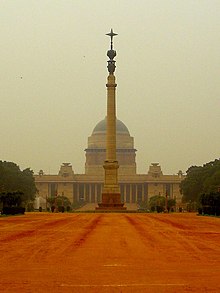
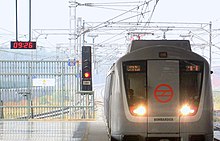

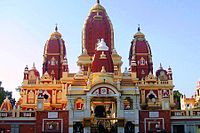


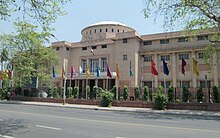



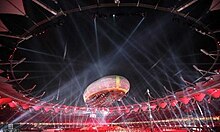

Nenhum comentário:
Postar um comentário